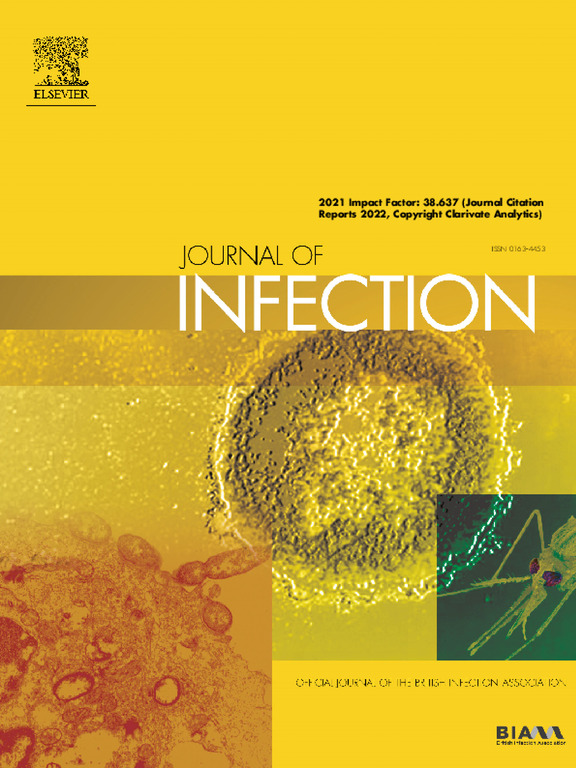前瞻性全基因组测序有助于鉴定和控制新生儿ICU中甲氧西林敏感金黄色葡萄球菌的传播。
IF 11.9
1区 医学
Q1 INFECTIOUS DISEASES
引用次数: 0
摘要
背景:传统的监测方法可能会错过卫生保健相关的病原体传播,特别是对于常见的药物敏感生物。目前尚不清楚前瞻性基因组分析是否可以帮助识别其他沉默的传播事件并为预防工作提供信息。方法:对某学术医院新生儿重症监护病房(NICU) 2022年2月至2024年3月期间的甲氧西林敏感金黄色葡萄球菌(MSSA)监测和临床分离株进行测序。从基因组流行病学分析中收集的见解用于控制大型MSSA集群,并随后校准感染控制措施。结果:在26个月的研究期间,共有2352名婴儿入院,其中318名被定植或感染了MSSA。在此期间,每月的MSSA发病率基本稳定,但全基因组测序显示16个MSSA集群(范围2-19个婴儿/集群)。与流行病学分析相结合的测序数据为不断升级的感染控制措施提供了信息,以控制持续发生的19名感染MSSA ST30的婴儿群集(包括加强手部卫生监测、加强环境和设备清洁、所有卫生保健工作者每天使用氯必定手和手臂擦洗、接触预防措施、MSSA携带者的非移民化),随后决定不再进一步加强(之前筛查所有工作人员是否携带MSSA)。以及随后一些干预措施的自由化(降低低风险婴儿的接触预防措施)。虽然强化感染控制措施控制了原发性ST30群集,但尽管采取了这些干预措施,在整个研究期间仍检测到低水平传播事件(范围2-8名婴儿)。解释:整合医疗保健相关病原体的前瞻性基因组学和流行病学分析有助于识别未被识别的传播集群,并为感染控制应对措施提供信息和校准。资助:本研究由BWH病理学部,P30 DK034854和马萨诸塞州生命科学中心(MLSC)资助。Jay Worley的工作得到了国家医学图书馆国家生物技术信息中心(NLM)、国家过敏和传染病研究所(NIAID)、国家卫生研究院(NIH)的支持。本文章由计算机程序翻译,如有差异,请以英文原文为准。
Prospective whole genome sequencing to aid the identification and control of methicillin-susceptible Staphylococcus aureus transmissions in a neonatal ICU
Background
Conventional surveillance methods may miss healthcare-associated pathogen transmission, particularly for common, drug-susceptible organisms. It is unclear if prospective genomic analyses can help identify otherwise silent transmission events and inform prevention efforts.
Methods
We sequenced methicillin-susceptible Staphylococcus aureus (MSSA) surveillance and clinical isolates in the neonatal intensive care unit (NICU) of an academic hospital between February 2022 and March 2024. Insights gleaned from genomic-epidemiologic analyses were used to control a large MSSA cluster and to calibrate infection control measures thereafter.
Findings
There were 2352 babies admitted during the 26-month study period, of whom 318 became colonized or infected with MSSA. Monthly MSSA incidence rates were largely stable throughout this period, but whole genome sequencing demonstrated 16 MSSA clusters (range 2–19 babies/cluster). Sequencing data integrated with epidemiologic analyses informed escalating infection control measures to control a sustained cluster of 19 babies infected with MSSA ST30 (including increased hand hygiene monitoring, enhanced environmental and equipment cleaning, contact precautions, decolonization of MSSA carriers), a subsequent decision against further intensification (foregoing screening all staff members for MSSA carriage), and the subsequent liberalization of some interventions (dropping contact precautions for lower risk babies). While intensified infection control measures controlled the primary ST30 cluster, low-level transmission events (range 2–8 babies) were detected throughout the study period despite those interventions.
Interpretations
Integrating prospective genomic and epidemiologic analyses of healthcare-associated pathogens can help identify unrecognized transmission clusters and inform and calibrate infection control response measures.
Summary
Prospective genotyping of surveillance and clinical methicillin-susceptible Staphylococcus aureus (MSSA) isolates in a neonatal intensive care unit over a 26-month period identified multiple MSSA clusters that were otherwise unappreciated and helped to both catalyze and calibrate infection control measures.
求助全文
通过发布文献求助,成功后即可免费获取论文全文。
去求助
来源期刊

Journal of Infection
医学-传染病学
CiteScore
45.90
自引率
3.20%
发文量
475
审稿时长
16 days
期刊介绍:
The Journal of Infection publishes original papers on all aspects of infection - clinical, microbiological and epidemiological. The Journal seeks to bring together knowledge from all specialties involved in infection research and clinical practice, and present the best work in the ever-changing field of infection.
Each issue brings you Editorials that describe current or controversial topics of interest, high quality Reviews to keep you in touch with the latest developments in specific fields of interest, an Epidemiology section reporting studies in the hospital and the general community, and a lively correspondence section.
 求助内容:
求助内容: 应助结果提醒方式:
应助结果提醒方式:


